
Otsego County, formerly known as Okkuddo County, is a county located in the U.S. state of Michigan. As of the 2020 census, the population was 25,091. The county seat is Gaylord. The county was founded in 1840 and organized in 1875.

Crawford County is a county in the U.S. state of Michigan. Its population was 12,988 as of the 2020 census. The county seat of Crawford County is Grayling, the county's only incorporated community.

Charlevoix County is a county in the U.S. state of Michigan. The county seat is Charlevoix, and the largest city is Boyne City. Located in the Northern Lower Peninsula, Charlevoix County is bisected by Lake Charlevoix, Michigan's third largest inland lake. As of the 2020 census, the county's population was 26,054.
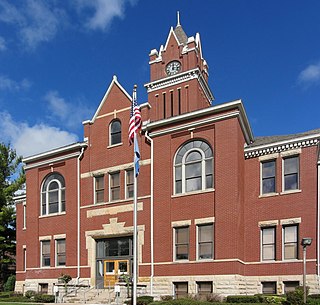
Antrim County is a county located in the U.S. state of Michigan. As of the 2020 census, the population was 23,431. The county seat is Bellaire. The name is taken from County Antrim in Northern Ireland.

Gaylord is a city in the U.S. state of Michigan. It is the county seat of Otsego County, and is the only city within the county. Gaylord had a population of 4,286 at the 2020 census, an increase from 3,645 at the 2010 census.

Richfield Springs is a village located in the Town of Richfield, on the north-central border of Otsego County, New York, United States. The population was 1,050 at the 2020 census. The name is derived from local sulfur springs.

The Smith–Harris House, listed on the National Register of Historic Places as the Thomas Avery House, is a 2+1⁄2-story clapboarded Greek Revival home on Society Road in East Lyme, Connecticut. It is believed that the farmhouse was built in 1845–1846 as a wedding gift for Thomas Avery and Elizabeth Griswold. It remained in the Avery family until 1877, when it was purchased by William H. Smith. By the 1890s, the farm was managed by Smith's younger brother, Herman W. Smith, and nephew, Frank A. Harris. In 1900, the two married Lula and Florence Munger, sisters, and both resided in the house. In 1955, the house was sold to the Town of East Lyme, and the sisters continued to live in the house until requiring a nursing home. The house was saved from demolition by citizens and restored. It opened on July 3, 1976, as a historic house museum, operated and maintained by the Smith–Harris House Commission and the Friends of Smith–Harris House. It is open from June through August and throughout the year by appointment. The Smith–Harris house was added to the National Historic Register of Places on August 22, 1979.

George I. Wilber House is a historic home located at Oneonta in Otsego County, New York. It was built in two phases, 1875 and about 1890. It is a three-story wood-frame structure on a stone foundation in the Queen Anne style. It features a three-story, round corner tower, cross gabled roof, and a large, very decorative wrap-around porch with a porte-cochere. In 1997 it became home to the Upper Catskill Community Council of the Arts.

The Charles G. Curtiss Sr. House is a private home at 168 S. Union St. in Plymouth, Michigan in the United States. It was listed on the National Register of Historic Places in 1993 and designated a Michigan State Historic Site in 1994.
Kramer House may refer to:
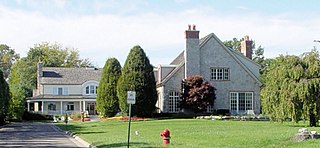
The Paul Harvey Deming House was a private residence located at 111 Lake Shore Rd. in Grosse Pointe Farms, Michigan. It was listed on the National Register of Historic Places and designated a Michigan State Historic Site in 1996 and demolished in 1997.

The William Hayden House is a private residence located at 108 West Pottawatamie Street in the city of Tecumseh in northeast Lenawee County, Michigan. It was designated as a Michigan Historic Site and added to the National Register of Historic Places on August 13, 1986.
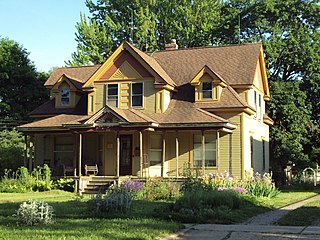
The George J. Kempf House is a privately owned residential house located at 212 East Kilbuck Street in the city of Tecumseh in Lenawee County, Michigan. It was designated as a Michigan State Historic State and listed on the National Register of Historic Places on August 13, 1986. It is located just around the corner from the Joseph E. Hall House.

The John W. Day House, also known as the Day-Dittman House, is a private residential structure located at 4985 Dryden Road in Dryden Township in southern Lapeer County, Michigan, United States. It was designated as a Michigan State Historic Site on September 26, 1987, and soon after added to the National Register of Historic Places on December 17, 1987.

The Chelsea Commercial Historic District is a historic district located along both sides of Main Street from Orchard to North Street in Chelsea, Michigan; the district also includes the adjacent 100 blocks of Jackson, East Middle, and West Middle Streets, as well as structures on Park, East, and Orchard Streets. It was listed on the National Register of Historic Places in 2011.
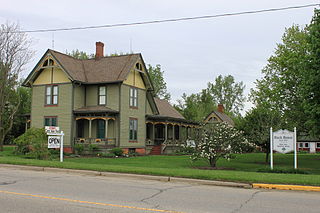
The Friend–Hack House, also known as the Hack House, was built as a private house, located at 775 County Street in Milan, Michigan. It was listed on the National Register of Historic Places in 1991, and currently houses the Hack House Museum.

The Richard C. Burtis House or Wedding Cake House is a Historic Site in Tuscola County, Michigan. The two-story Second Empire building was built from 1879 to 1880 for Richard C. Burtis, a shoemaker and local landowner. Ornamentation includes brackets and a decorative frieze supporting a mansard roof with decorative slate shingle. A bay window topped by a steep octagonal tower dominates the front facade. The Burtis home appeared on Travel Channel in 2019.
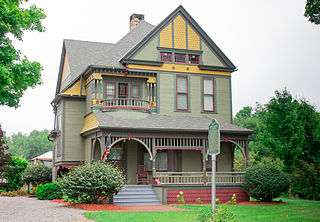
The John Carveth House, also known as the Aaron Clark House or the Lone Willow Farm, is a private house located at 614 West Main Street in Middleville, Michigan. It was designated a Michigan State Historic Site in 1992 and listed on the National Register of Historic Places in 1992.

The Frank J. Cobbs House is a private house located at 407 E. Chapin Street in Cadillac, Michigan. It was designated a Michigan State Historic Site in 1985 and listed on the National Register of Historic Places in 1988.

The James A. and Lottie J. (Congdon) Quick House is a private house located at 120 North Center Avenue in Gaylord, Michigan. It was listed on the National Register of Historic Places in 2016.























